|
Click any typewriter
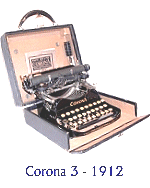
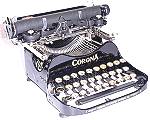
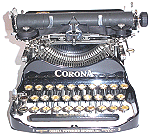

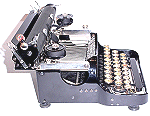
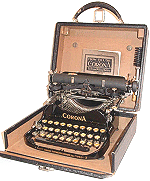
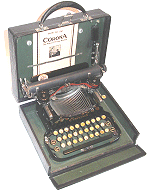
Corona
3 - 1920
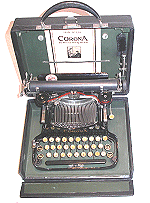
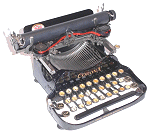
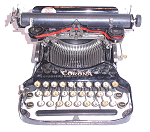

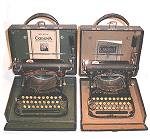
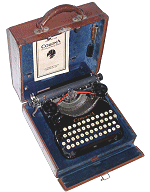
Corona 4 - 1924
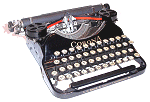
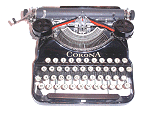

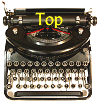

|
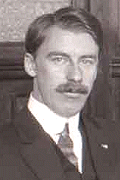 If the Standard Typewriter Company was extremely fortunate to have Frank Rose
as its founding genius, it was just as fortunate to have Otto Petermann in charge
of new development. The machine he developed from Rose’s original design
became a classic that dominated its market for nearly half a century, was widely
imitated, and led to the founding of one of the world’s largest typewriter
companies. Petermann changed the fabricated aluminium frame for a casting and the
front plate for pressed steel, yet managed to retain almost the same degree of
lightness and portability. The new machine weighed in at just six and three
quarter pounds (a pound more than the Standard Folding) making it still one of
the lightest and most portable machines available . Perhaps just as
significantly, this time the name was changed to something
simple that overseas customers could pronounce and understand -- Corona. If the Standard Typewriter Company was extremely fortunate to have Frank Rose
as its founding genius, it was just as fortunate to have Otto Petermann in charge
of new development. The machine he developed from Rose’s original design
became a classic that dominated its market for nearly half a century, was widely
imitated, and led to the founding of one of the world’s largest typewriter
companies. Petermann changed the fabricated aluminium frame for a casting and the
front plate for pressed steel, yet managed to retain almost the same degree of
lightness and portability. The new machine weighed in at just six and three
quarter pounds (a pound more than the Standard Folding) making it still one of
the lightest and most portable machines available . Perhaps just as
significantly, this time the name was changed to something
simple that overseas customers could pronounce and understand -- Corona. 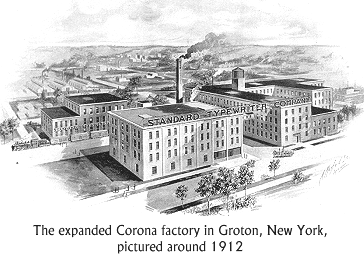 The machine was an instant success and production went
into overdrive at its Groton factory, trying to keep up with market demand from
home and abroad - something it did not manage to achieve for a decade.
How
the market took to the new machine is told by the sales figures. In 1912, the
company sold some 6,000 Corona 3s. By 1914, production
had doubled to12,000, by 1915,
it had nearly doubled again to 23,000 and by 1918 it was 55,000. The
following year, 1919, production was a staggering 153,000 machines. At $50 per
machine, that’s revenue of around $7.5 million – significant even at today’s
prices. There was one other change with the Corona 3; now the
little folding machine was painted glossy black, like every other typewriter on the
market -- although at one stage serious thought was given to painting it in aluminium paint!
The Corona was a runaway success and set every other typewriter maker scratching
their heads wondering how to compete with this phenomenon. The machine was an instant success and production went
into overdrive at its Groton factory, trying to keep up with market demand from
home and abroad - something it did not manage to achieve for a decade.
How
the market took to the new machine is told by the sales figures. In 1912, the
company sold some 6,000 Corona 3s. By 1914, production
had doubled to12,000, by 1915,
it had nearly doubled again to 23,000 and by 1918 it was 55,000. The
following year, 1919, production was a staggering 153,000 machines. At $50 per
machine, that’s revenue of around $7.5 million – significant even at today’s
prices. There was one other change with the Corona 3; now the
little folding machine was painted glossy black, like every other typewriter on the
market -- although at one stage serious thought was given to painting it in aluminium paint!
The Corona was a runaway success and set every other typewriter maker scratching
their heads wondering how to compete with this phenomenon. 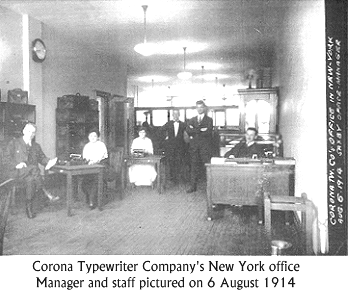 Yet it was to be
nearly a decade before the big two desk machine makers, Underwood and
Remington, responded with their first portable machines, in 1919 and 1920
respectively. The
Corona 3 had the timeless elegance of a great original design combined with
superb functionality. For $50 anyone could own a typewriter than he or she
could use at home, in the office, on the train -- literally anywhere. The
new brand
name proved so effective that in 1914, the Standard Typewriter Company changed its
name to Corona Typewriter Company Inc., a name that appeared on hundreds of
thousands of machines. In 1920, the company made the only significant
design changes to the Corona 3 when they added shift keys to the right of the
keyboard, making the frame wider at the front. The design team took the
opportunity to extend the carriage by 1 inch so the machine could accommodate
9-inch business envelopes. From machines with serial number 500,000 up, machines
were also equipped with a ribbon reversing mechanism. Apart from this,
the design remained unchanged until 1941 Yet it was to be
nearly a decade before the big two desk machine makers, Underwood and
Remington, responded with their first portable machines, in 1919 and 1920
respectively. The
Corona 3 had the timeless elegance of a great original design combined with
superb functionality. For $50 anyone could own a typewriter than he or she
could use at home, in the office, on the train -- literally anywhere. The
new brand
name proved so effective that in 1914, the Standard Typewriter Company changed its
name to Corona Typewriter Company Inc., a name that appeared on hundreds of
thousands of machines. In 1920, the company made the only significant
design changes to the Corona 3 when they added shift keys to the right of the
keyboard, making the frame wider at the front. The design team took the
opportunity to extend the carriage by 1 inch so the machine could accommodate
9-inch business envelopes. From machines with serial number 500,000 up, machines
were also equipped with a ribbon reversing mechanism. Apart from this,
the design remained unchanged until 1941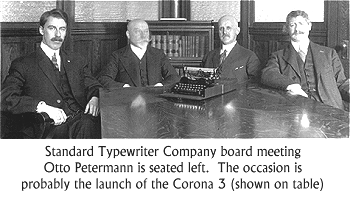 when Corona, like other manufacturers,
retooled for war production. In 1926, faced with increasing
competition from Underwood, Remington and -- now -- Royal, Corona merged its
manufacturing interests with leading desk machine manufacturer L.C. Smith and
Company to form the hybrid L.C.Smith and Corona Typewriters. Two years earlier,
in 1924, the
company had finally launched a four-bank keyboard machine, the Corona Four, although
sales of the Corona 3 continued little changed. Though commercially successful
(remaining in production from 1924 to 1939) the Corona 4 is a rather
disappointing machine. At best, it can only be described as a workmanlike design
with none of the originality or character of its predecessor machine. In 1946 the company name
was changed again to Smith-Corona, the form it carried until the company finally
ceased manufacturing typewriters in 1997. Smith Corona continued to develop portable models until
the end. Most notably, it introduced the first electric portable
typewriter
in 1957. when Corona, like other manufacturers,
retooled for war production. In 1926, faced with increasing
competition from Underwood, Remington and -- now -- Royal, Corona merged its
manufacturing interests with leading desk machine manufacturer L.C. Smith and
Company to form the hybrid L.C.Smith and Corona Typewriters. Two years earlier,
in 1924, the
company had finally launched a four-bank keyboard machine, the Corona Four, although
sales of the Corona 3 continued little changed. Though commercially successful
(remaining in production from 1924 to 1939) the Corona 4 is a rather
disappointing machine. At best, it can only be described as a workmanlike design
with none of the originality or character of its predecessor machine. In 1946 the company name
was changed again to Smith-Corona, the form it carried until the company finally
ceased manufacturing typewriters in 1997. Smith Corona continued to develop portable models until
the end. Most notably, it introduced the first electric portable
typewriter
in 1957.

| Perhaps more than any other manufacturer, Corona caught the public
imagination in the era following the First World War with its constant
advertising campaigns emphasising the freedom that portable typewriters gave to
women. |
| To see the impact that the portable typewriter had on women's social
position, click here. |
If you have
found the information on this site useful, visit our sister site at
http://www.ministry-of-information.com
The Portable Typewriter Website
Copyright © Richard Milton 2003-2004
Photographs by courtesy of The Cornelia and Peter Weil Collection
|
